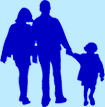© Copyright 2012 Red Circle Rainbow. All Rights Reserved.
Autism Glossary - What do all those terms mean?
Glossary
AAC: Augmentative Assistive Communication
ABA: Applied Behavioral Analysis is the use of techniques and principles to bring about meaningful and positive change in behavior
ADD: Attention Deficit Disorder. Currently referred to as ADHD inattentive. Difficulty staying focused and organized, without hyperactivity. (Currently, ADD is referred to as ADHD, type(s) Inattentive, hyperactive and combined.
ADHD: Attention Deficit Hyperactivity Disorder. Difficulty staying focused, organized with hyperactivity and problems with impulse control not typical for a person's age.
Auditory Processing: Recognizing and understanding what you hear.
APD: Auditory Processing Disorder: Difficulty recognizing and interpreting sounds, as with speech. Normal ear and hearing physical structure.
Autism: A Neurodevelopmental Disorder.
Co-morbid Disorders: Disorders that commonly accompany other disorders.
DT: Discrete Trial (Old School ABA) More demand based. Multiple definitions.
Expressive language: Expressing yourself using language. Can be verbal, sign or assistive.
Fine Motor: Using the small muscles, such as in the fingers and hands.
Floor Time: Developed by Dr. Stanley Greenspan. Similar to "Tummy Time" with infants, getting down on the floor with somebody while playing and interacting.
Gross Motor: Using the large muscles in the body - walking, running, skipping, throwing a ball.
Hippotherapy: Any type of therapy that uses a horse.
Occupational Therapy: Therapy addressing the occupation of living.
Proprioceptive: The reaction of the body and mind to internal stimuli.
Proprioceptor: A sensory receptor, found chiefly in muscles, tendons, joints, and the inner ear, that detects the motion or position of the body or a limb by responding to stimuli arising within the organism.
PRT: Pivotal Response Training, or Pivotal Response Therapy is a type of ABA therapy that is play based and child initiated. More motivation based.
Receptive language: Ability to understand what others are saying.
SLP - Speech Language Pathologist.
Speech Therapy: Therapy that promotes verbal speech, including the muscles associated with speech.
TEACCH: Treatment and Education of Autistic and Related Communication-Handicapped Children. Based on the philosophy that autism makes people different, but not inferior. Visual support systems and organization are used to support autistic learners.
Website Directory - Quick Links




